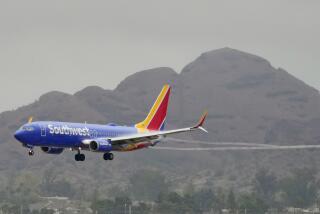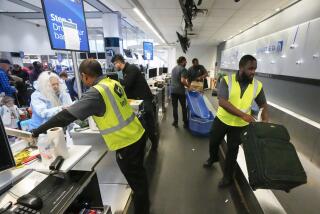Some Changes Are Afoot in Frequent-Flier Land
- Share via
If you are a business traveler enrolled in one or more elite airline clubs, you probably check your frequent-flier miles often.
But this column is for the rest of us, the leisure travelers who occasionally dip our toes into the arcane waters of awards, rewards and other mileage minutiae. It’s time to take the plunge because the mileage rules are changing. Booking that free trip now instead of later could be one of the smarter travel decisions you make this spring.
A roundup of recent changes in the frequent-flier world:
* Higher mileage minimums: Some airlines are getting rid of off-peak award levels, which typically allow travelers to book free flights for fewer miles between September and May. Instead of using 20,000 miles to book a domestic trip in that period, for instance, you’ll need 25,000 miles, the same as in peak travel periods. At Continental and Northwest, you have until June 1 to book under the current, more generous rules.
Alaska Airlines is revising its unique “bonus” miles program that adds miles to your account when you reach various thresholds within a calendar year. You now get 10,000 bonus miles when you reach 35,000 miles, then 10,000 more at 10,000-mile increments. But as of April 30 you will have to rack up 75,000 miles in one year to receive any bonus miles. (You’ll get 50,000.) Also starting that day, a round-trip upgrade from coach to first class will cost 10,000 miles, not 5,000.
Booking online can boost miles. Among current offers: For travel through May 31, America West offers 3,000 extra miles for every round trip bought at www.americawest.com. For travel through March 20, Delta knocks 5,000 miles off award minimums for domestic tickets confirmed at www.delta.com/awardticket. In January, Southwest announced it would extend its program of double credit for online bookings at www.southwest.com through Dec. 31.
* Buying miles with cash: Need a few more miles to get a ticket? Buying them is an option that has been around for a while, but “in the last half of last year ... everyone got into mileage sales,” says Randy Petersen, publisher of Inside Flyer magazine
When should you use this option? Typically, the airlines charge about 2.5 cents per mile, but add-ons such as service fees of $15 to $25 plus 7.5% federal tax may boost the actual price to more than 3 cents per mile.
“I think the miles they sell are prohibitively expensive,” says Petersen, who estimates the airlines’ cost at less than a penny per mile. But he says it may be worth it for a leisure traveler who is a few thousand miles short of qualifying for a free domestic ticket.
Say you have 22,000 miles but need 25,000 for a domestic ticket. At 3 cents per mile, you pay $90 for 3,000 miles to top off your account and get to use the free ticket. But if you need to buy 15,000 miles, you’ll pay $450--more than many round-trip domestic fares.
A little-known way to top off miles is to go into debt on your frequent-flier account, which some airlines let you do if you’re a very frequent flier or if you use the airline’s credit card regularly, Petersen says.
Among recent converts to mileage sales are American, which last month extended its program through July 31; US Airways, which began the program last month for a limited time (it has expired for domestic tickets but is still open for transatlantic, Mexican and Caribbean travel); and America West, which started it in November. Northwest plans to add a program this year. In many cases you can buy miles to give as a gift.
* More ways to earn awards: There are, of course, thousands of ways to get miles without ever stepping on a plane, using airline-allied credit cards or doing business with hotels and other airline partners--far more than could be listed in this column. Here are some deals that expire soon:
Until March 31 Continental frequent fliers can earn double points on KLM flights. Through March 20, Delta frequent fliers can earn double miles on selected flights and classes. Through May 31, Northwest frequent fliers can earn 2,000 miles by checking in for flights online or at airport kiosks; through April 30, first-time buyers earn 2,500 miles for booking online at www.nwa.com. For travel through April 28, US Airways offers 5,000 to 30,000 bonus miles for trips between the U.S. and Europe, depending on the class and frequency of travel.
A quirky but timely option: You can earn miles through some carriers while paying income taxes. Delta, for instance, awards two miles for every dollar you pay Uncle Sam through its SkyMiles credit card from American Express. America West gives you 500 to 2,000 miles for using H&R; Block tax services for the first time.
* A less taxing idea: More good news for frequent fliers came last month when the IRS clarified its policy on miles earned on business travel. It said such miles would not be taxed as income when they are converted to personal use. Some legal experts had viewed these miles as compensation that should be taxed, but the IRS indicated it is too difficult to place a value on miles or to separate personal from business accounts.
* The end of blackouts: Northwest in January announced it was eliminating blackout dates, the practice of barring award travel during certain holiday periods in the U.S. and on transatlantic travel on summer weekends. Some other airlines copied the move. But the benefit to travelers is less than it might appear.
As competitors note, eliminating the blackout label without actually making more seats available for award travel on those dates doesn’t help frequent fliers get more flights. Petersen estimates major airlines set aside an average of 10% of their seats for award travel, but it varies widely by route and season. Not being able to book award travel remains a persistent complaint of frequent fliers. And often only a handful of dates are officially blacked out in the U.S. Alaska Airlines, for instance, had 13 last year, 11 this year and only eight planned for 2003, says spokesman Jack Walsh.
Fewer mailings: If you haven’t heard from your frequent-flier program in a while, this may be the reason: Some airlines have cut back on mailings and instead post updates on their Internet sites or via e-mail. “If you haven’t decided to be an electronic junkie, you’re almost never going to hear about the offers out there,” Petersen says. Besides signing up on the airlines’ sites, it’s worthwhile to surf www.webflyer.com, www.smarterliving.com and other services that regularly scan and post the latest frequent-flier offers. A savvy travel agent should be on top of these offers too.
*
Jane Engle welcomes comments and suggestions but cannot respond individually to letters and calls. Write Travel Insider, Los Angeles Times, 202 W. 1st St., Los Angeles, CA 90012, or e-mail [email protected].
More to Read
Sign up for The Wild
We’ll help you find the best places to hike, bike and run, as well as the perfect silent spots for meditation and yoga.
You may occasionally receive promotional content from the Los Angeles Times.






